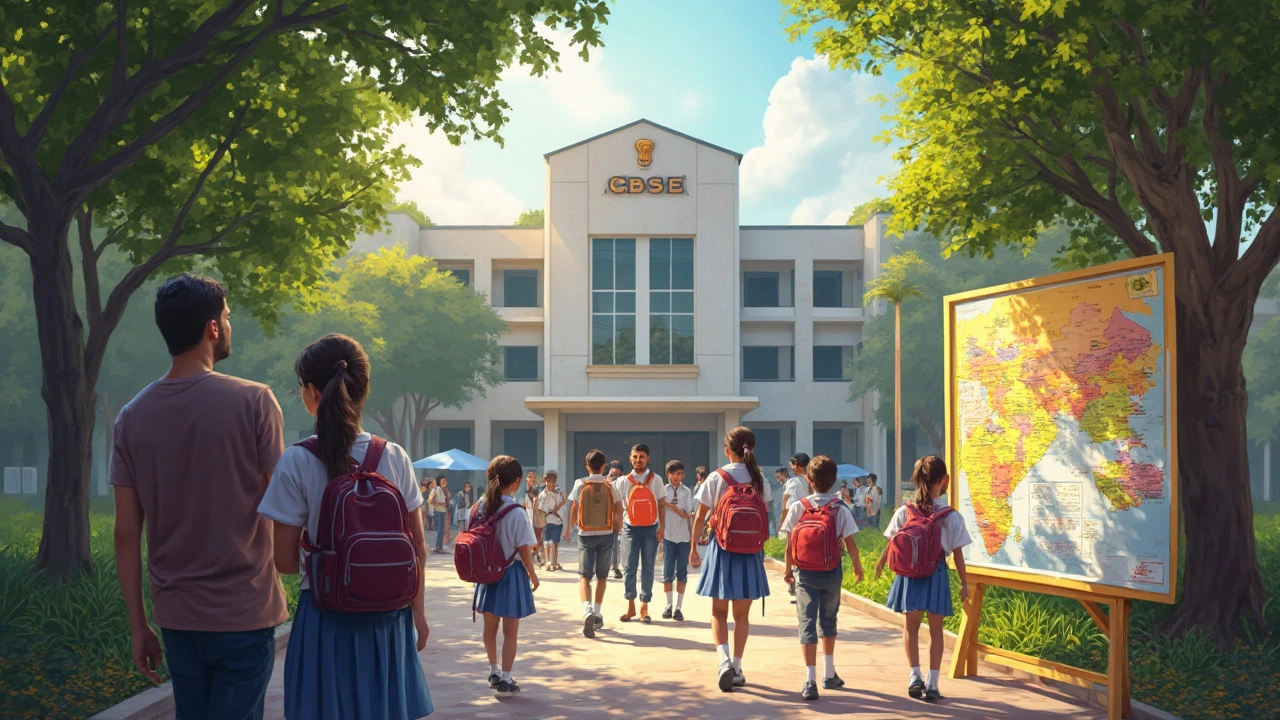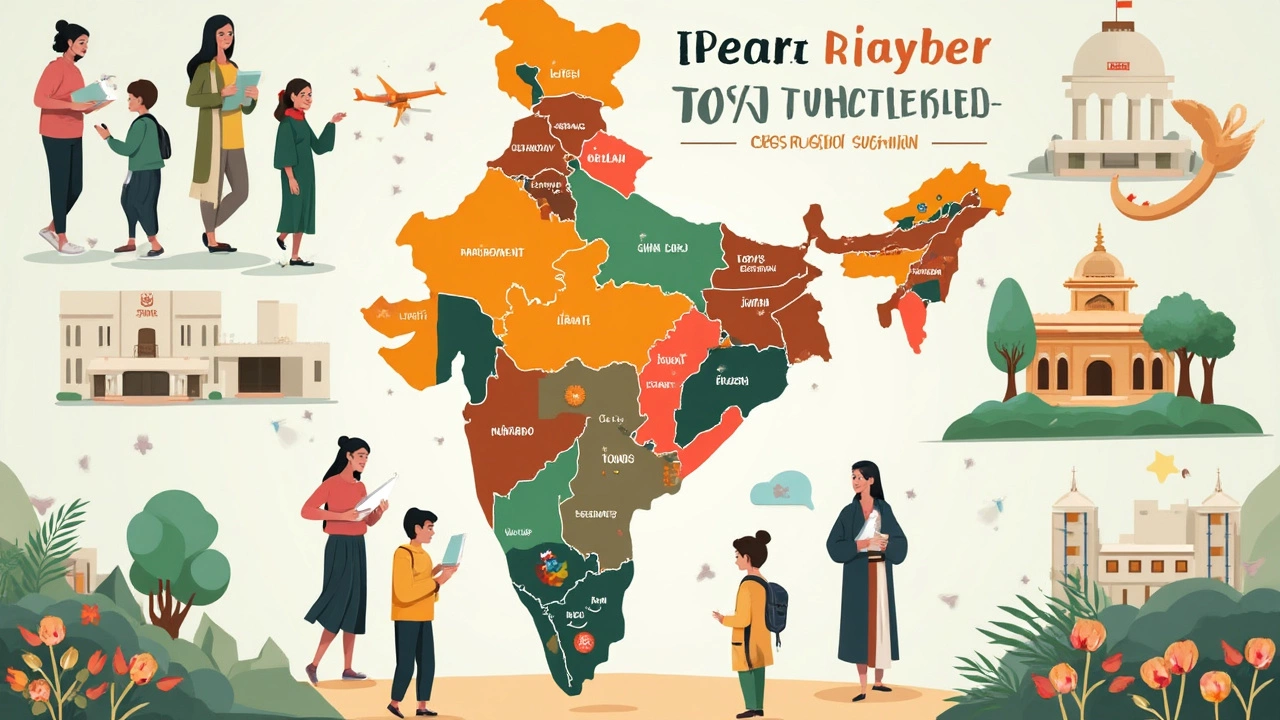
Thinking about CBSE schools for your kid? Or maybe you’re just genuinely curious—where do you find the most of them in India anyway? This isn’t just trivia. The state with the most CBSE schools reveals a lot about education choices, job markets, and even the way families move for better options.
The answer can actually help you if you’re deciding where to relocate or just trying to understand the school competition in your city. We’re talking real impact here—not just boring charts and numbers. Knowing which state dominates in CBSE schools might even change your plans about where you want your child to study, especially if you’re chasing those board results and holistic education that CBSE promises. Let’s chop it all up and get straight to the facts.
- CBSE in India: A Quick Overview
- Top States: The Numbers Game
- Why Do Some States Lead?
- What It Means for Parents and Students
- Choosing the Right CBSE School
CBSE in India: A Quick Overview
If you’ve gone to school in India or know someone who has, you’ve probably heard about CBSE. It stands for the Central Board of Secondary Education and is one of the biggest school boards in the country. The cool thing about CBSE is that it covers both private and government schools, and its syllabus is famous for prepping students for national-level entrance exams like IIT-JEE and NEET.
So, how big is the CBSE network? As of the 2024-25 academic year, there are over 28,800 CBSE-affiliated schools spread across India and even overseas. This includes Kendriya Vidyalayas, Jawahar Navodaya Vidyalayas, and private schools. The CBSE schools count keeps growing every single year as more parents look for stability and standardized education.
Check this out for a quick idea:
| Year | CBSE-Affiliated Schools (India) |
|---|---|
| 2015 | 17,093 |
| 2020 | 22,299 |
| 2024 | 28,800+ |
CBSE schools pop up everywhere—from big, buzzy cities to quiet, small towns. One reason? The board offers one single syllabus across the nation, so if a family shifts from Chennai to Chandigarh, their kid doesn’t have to stress about switching textbooks or adjusting to a whole new system.
The exams and assessments are pretty streamlined, which means everyone’s on the same playing field, whether you’re in Mumbai or a remote Himalayan town. All this has made CBSE super popular, especially among people who move around for work (like government or defense jobs).
Plus, CBSE results matter a lot. Scores from these schools play a big part in how students get higher education opportunities, especially if they’re aiming for competitive exams.
Top States: The Numbers Game
If you go by the numbers, Uttar Pradesh totally takes the lead for the highest count of CBSE schools in India. As of 2024, this state has more than 3,100 CBSE-affiliated schools—that’s seriously ahead of the pack. Delhi, despite being smaller by size, is also packed with CBSE schools (over 1,000) because so many families here prefer the board, especially with all those government and private sector jobs pulling people in from all over the country.
Here’s a quick look at how the top states stack up when it comes to CBSE school numbers:
| Rank | State | Number of CBSE Schools (2024) |
|---|---|---|
| 1 | Uttar Pradesh | 3,100+ |
| 2 | Delhi | 1,000+ |
| 3 | Maharashtra | 900+ |
| 4 | Rajasthan | 850+ |
| 5 | Karnataka | 800+ |
Don’t miss Tamil Nadu and Andhra Pradesh either—they’re both seeing a steady climb, partly because tech and business hubs here attract families serious about good schooling. But UP’s numbers are in a league of their own. One reason is its sheer size and population, but it’s also about demand—parents want national-level education for their kids, so the schools keep popping up.
Interestingly, a few northeast states like Arunachal Pradesh and Mizoram have way fewer CBSE schools (sometimes just a handful) simply because of lower population and more focus on state boards. So, if you’re in UP or Delhi, you’ve literally got dozens of choices nearby. But in places like the northeast or more remote regions, options are pretty tight.

Why Do Some States Lead?
Ever wondered why a few states just wipe the floor when it comes to the number of CBSE schools? It’s not random luck—there’s some real logic behind it. The big leaders are usually places like Uttar Pradesh, Delhi, and Maharashtra. Here's a look at the numbers from 2024:
| State | Approx. Number of CBSE Schools |
|---|---|
| Uttar Pradesh | 4200+ |
| Maharashtra | 2300+ |
| Delhi | 1910+ |
| Tamil Nadu | 1600+ |
| Rajasthan | 1400+ |
So, what’s pushing these numbers up in certain states?
- Population Power: States with huge populations, like Uttar Pradesh and Maharashtra, simply need more schools to handle the crowds. More families mean more students enrolling every year.
- Urbanization: Delhi and Mumbai lead here. When cities grow, everyone wants good schools. CBSE is a popular pick for its English curriculum and national edge.
- Job Opportunities: Many folks move for jobs in IT hubs or government sectors (think Delhi NCR, Pune, Chennai), and they look for CBSE schools that help their kids adjust no matter which state they’re posted to next.
- Educational Policies: Certain state governments actually encourage more CBSE affiliations. For instance, Delhi has a big push for private institutions, and Tamil Nadu has strong support for English medium education.
- Parental Perceptions: In big states, families see CBSE as the ticket to crack national-level entrance exams like JEE or NEET. So, more demand means more schools opening doors.
It’s really a mix of numbers game, city life, migration, and the chase for quality education. The more urban and migration-friendly a state, the higher its CBSE school count. Also, once a region gets known for good CBSE schools, it attracts even more students and teachers, creating a kind of positive cycle where growth feeds more growth.
What It Means for Parents and Students
If your state is packed with CBSE schools, you’ve got way more choices on where to enrol your child. That means you can check out several schools, compare facilities, sports grounds, coaching for competitive exams, or even extra language options. In big states like Uttar Pradesh and Delhi, parents often shortlist ten or more possible schools before picking the final one. If you’re in a smaller state with fewer CBSE schools, you might get stuck with just one or two options and barely any room for comparison.
Here’s the thing: more CBSE schools can also lead to stiffer competition for admissions, especially in popular metro cities. In many parts of Delhi-NCR, for example, top CBSE schools get thousands of applications for a few hundred seats every year. On the flip side, more supply means you can find a school closer to home instead of settling for a long commute. Some states back their schools with modern labs, sports facilities, and coaching for JEE or NEET exams, which could mean a better shot at top results for your child.
Take a look at real numbers for 2024 published by CBSE:
| State/UT | Number of CBSE Schools |
|---|---|
| Uttar Pradesh | 4200+ |
| Maharashtra | 2300+ |
| Delhi | 1700+ |
| Rajasthan | 1600+ |
| West Bengal | 1200+ |
Bigger numbers in a state don’t always mean better quality though. The best CBSE schools usually have a strong record in board results, good infrastructure, and active co-curricular scenes. You should definitely visit schools, chat with current parents, and spend time on their websites before applying. Here’s a quick checklist for parents:
- Check board results from the last few years
- Visit the campus and check labs, sports, and library facilities
- Ask about teacher experience and student-teacher ratio
- Look into coaching and support for entrance exams
- See what languages and activities are offered
For students, more CBSE schools means a better shot at landing in a school that matches your interests—be it sports, science, humanities, or commerce. It also means easier transfers if parents get relocated, since many major cities have a cluster of CBSE schools familiar with handling school-to-school migration. The real takeaway? Knowing your state’s CBSE scene gives you an edge, whether you’re picking a school for your first grader or moving to a new city.

Choosing the Right CBSE School
Finding the right CBSE school can get overwhelming real fast, especially when you see hundreds of options in bigger states like Uttar Pradesh or Delhi. It's more than just picking the closest one—there’s a lot on the line, from teaching quality to extra activities and even how well the school manages tough CBSE board exams.
Start by checking if the school is actually affiliated with the Central Board of Secondary Education. You’d be surprised at how often schools misrepresent this. The official CBSE website lets you search affiliations directly. Look up the school's code and see if it’s updated for the current year.
Facilities matter too. Is there a science lab, library, playground, or tech-enabled classrooms? In my experience as a parent (and part-time homework wrangler to Leo, my dog, who tries to eat every worksheet in sight), little things like clean bathrooms or a safe school bus can be the dealbreaker.
Don’t just trust fancy brochures or ads. It's way better to do these:
- Visit during school hours and watch a class.
- Talk to teachers and current parents, not just the principal.
- Find out the teacher-student ratio: Aim for under 30 kids per classroom, since crowded classes make it hard for any real learning to happen.
- Ask about their last three years’ board results and what extra coaching is offered.
Pay attention to fees as well. CBSE schools can range from government-aided with low fees to private internationals that charge in lakhs. Here’s a quick look at the average annual fee range in a few popular states:
| State | Avg. Annual Fees (₹, in 2025) | No. of CBSE Schools |
|---|---|---|
| Uttar Pradesh | 20,000 – 60,000 | over 6,800 |
| Delhi | 35,000 – 1,20,000 | over 2,000 |
| Maharashtra | 25,000 – 90,000 | about 1,900 |
| Tamil Nadu | 20,000 – 75,000 | about 1,800 |
The CBSE schools syllabus is the same everywhere, but the way each school teaches, the after-school programs, and the type of crowd your kid will meet—that’s what really sets places apart. Check if the school updates parents regularly and welcomes feedback. Schools that listen to families usually handle problems better.
Finally, trust your gut after all the Googling and asking around. Your child’s future, daily routine, and happiness all spin around this big decision.
